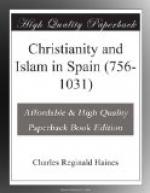[1] Lockhart.
[2] Unless the ballads were
written later than 1250—i.e.,
after Rodrigo of Toledo had
made the story known by his
history.
[3] “Espana Sagrada,”
xix. 329—“Privilegiam quod dicitur
votoram, anno 844 a rege Ranemiro
I., ecclesiae B. Jacobi
concessae.”
[4] Lucas Tudensis, “Chronicon Mundi,” bk. iv.
[5] “Hispaniae Chronicon,” 783 A.D.
[6] “Anacephalaiosis,” sec. 51.
[7] III. c. 7.
[8] Koran, xvi. ver. 109, Sale’s note.
CHAPTER VIII.
THE MUWALLADS.
That the conversions from Christianity to Islam were very numerous at first we can sufficiently gather from the fact that the new converts formed a large and important party in the State, and almost succeeded in wresting the government of Spain from the Arabs. The disorder and civil war which may almost be said to have been chronic in Spain during the Arab dominion were due to the fact that three distinct races settled in that country were striving for the mastery, each of these races being itself divided into two bitterly hostile factions. The Arabs were split up into the two factions of Yemenite or Beladi Arabs, the descendants of Kahtan, and Modharites, the Arabs of Mecca and Medina, who claimed descent from Adnan.[1] To the latter section belonged the reigning family of Umeyyades. The Berbers, who looked upon themselves as the real conquerors of Spain, and whose numbers were subsequently reinforced by fresh immigrations, were composed of two hostile tribes of Botar and Beranis. Thirdly, there were the Spaniards, part Christian, part Mohammedan; the latter being either renegades themselves or the descendants of renegades. These apostates were called by the Arabs Mosalimah, or New Moslems,[2] and their descendants Muwallads,[3] or those not of Arabic origin. The Christians were either tribute-paying Christians, called Ahlu dh dhimmah; or free Christians, under Moslem supremacy, called Ajemi;[4] or apostates from Islam,[5] called Muraddin. The Muwallads, in spite of the Mohammedan doctrine of the equality and brotherhood of Moslems, were looked down upon with the utmost contempt by the pure-blooded Arabs.[6] Their condition was even worse than that of the Christians, for they were, generally speaking, excluded from lucrative posts, and from all administration of affairs—a dangerous policy, considering that they formed a majority of the population.[7] Stronger and more humane than the Berbers, they were friends of order and civilization. Intellectually they were even superior to the conquering Arabs.[8]
The natural result of their being Spaniards by race, and Arabs by religion, was that they sided now with one faction and now with another, and at one time, under the weak Abdallah (888-912), were the mainstay of the Sultan against his rebellious subjects. After breaking with the Sultan they almost succeeded in gaining possession of the whole kingdom, and carried fire and desolation to the very gates of Cordova.[9]




